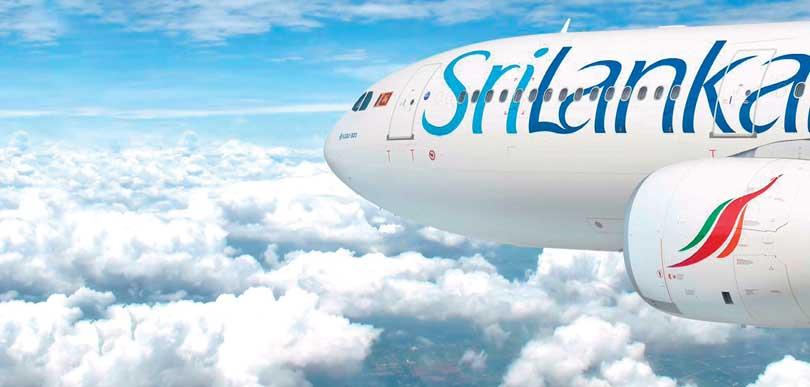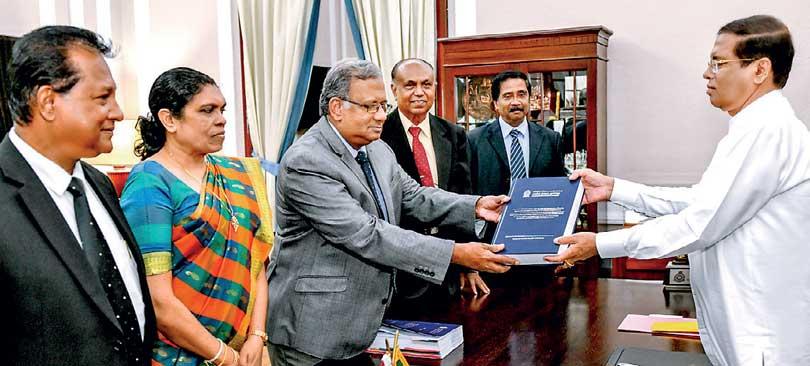Reply To:
Name - Reply Comment
Incurs colossal losses after termination of Emirates treaty

 Revelations from PCoI
Revelations from PCoI
After terminating its contract with Emirates Airlines in 2008, national carrier SriLankan Airlines (SLA) encountered various issues over liabilities. By 2010, the airline lacked funds to proceed with re-fleeting plans and was facing mounting challenges and a precarious future. Against this backdrop, the Presidential Commission of Inquiry (PCoI) into alleged irregularities at SriLankan Airlines, SriLankan Catering and Mihin Lanka concluded sessions last week. The PCoI handed over its final 1800-page report on July 2 to President Maithripala Sirisena including a 900-page annexure with recommendations and observations based on testimonies made during proceedings. Statements were recorded from 560 persons while 150 officials testified before the body on alleged irregularities under different SLA managements.
The PCoI was chaired by retired Supreme Court (SC) Justices Anil Gooneratne and Gamini Amarasekara, retired High Court (HC) Judge Piyasena Ranasinghe, retired Deputy Auditor General (DAG) Don Anthony Harold and Sri Lanka Accounting and Auditing Standards Monitoring Board Director-General Wasantha Kapugama. Former Additional Solicitor Generol Neil Unamboowe PC along with Senior State Counsel Fazly Razik and State Counsel (SC) Chathura Gunathilake led the testimonies on these matters. During proceedings, the PCoI confronted diverse issues pertaining to the termination of the Emirates contract. This article predominantly focuses on two key, interconnected matters through which several crucial revelations were made at the commission.
It was revealed that a letter to review the draft business plan sent to then SLA Chairman Nishantha Wicramasinghe had noted Amerasian Corporation was a joint venture of Via Capital. However, the proposal sent by Via Capital did not indicate Amerasian Corporation as a joint venture. Via Capital was only recently established and has no extensive experience in aviation services
Re-fleeting, re-delivering and cancellation of aircraft
Under the Emirates management, SLA savoured a profit of Rs.568 million in the financial year 2006/07. In the following year,it earned a profit of a whopping Rs.4.4 billion. These profits were earned by selling and leasing aircraft. Company Head of Finance Yasantha Dissanayake informed the commission that in 2016, SLA terminated four Airbus A350-900 leases executed under the previous management. The airline lost Rs.14 billion (USD 90.5 million) due to the cancellation of three Airbus leases, accounting for half the losses in the financial year 2016/17.
“SriLankan has been incurring losses since the departure of Emirates. According to the 2008/09 Annual Report, soon after Emirates left the national carrier, the company lost Rs.9.3 billion during then Chairman Nishantha Wickramasinghe’s tenure,” Mr. Dissanayake said, testifying before the commission.
Further inquiries revealed that several companies including Amerasian Corporation made unsolicited proposals from 2010 to 2014 regarding the restructuring and acquisition of new aircraft to SLA. Manoj Vaas Gunawardena, CEO and incumbent Regional Head of Europe and Americas of SLA, informed the commission that he was unaware of engagements with Amerasian Corporation during restructuring efforts.
“Amerasian Corporation had not contacted SriLankan directly for the refurbishment of the airline. But it had contacted then Secretary to the Ports and Civil Aviation Ministry Ranjith de Silva who in turn sent the relevant documents to then SriLankan Chairman Nishantha Wicramasinghe,” Mr. Gunawardena said. He also revealed that as then CEO, the relevant documents and letters were not copied to him.
The decision by SLA to purchase four Airbus A350-900 and lease another four cost more than 50 per cent of the airline’s total assets in 2013. The Company Act 184.2 stipulates that such major transactions require the company board to adopt a resolution for further deliberations.
However, CEO Kapila Chandrasena purchased the aircraft without consulting the board and they were informed of the deal only after it was made. In an email from Mr. Chandrasena to Mr. Dissanayake on August 12, 2013, Mr. Chandrasena mentioned that a “shareholder” had instructed him to choose the Airbus company and type of aircraft for purchase. In the email, Mr. Chandrasena authorised Mr. Dissanayake to proceed with the deal.
When former Additional Solicitor General (ASG) Neil Unamboowe PC asked who the unnamed “shareholder” was, Mr. Dissanayake replied that since the Treasury was the main shareholder, then Treasury Secretary P.B. Jayasundara may have authorised the deal. He added that the deal was later cancelled which led to SLA losing Rs.14.3 billion (USD 90.5 million) due to a cancellation penalty. The decision to cancel the deal was made after the board of directors approved a new business plan.
“The sequence of events started with the new government coming into power in 2015 and refusing to pay the previous budgetary allocation of USD 510 million for a capital infusion which had commenced under the Rajapaksa administration. We were to receive USD 125 million in 2015 and we didn’t receive this sum. When we requested Cabinet approval for the money, they asked us to come up with a new business plan,” Mr. Dissanayake said.
The fresh business plan had to consider the new government’s directives to make the airline more commercially-viable. When the Airbus A350-900 aircraft were leased in 2013, the airline was aiming to be a full-service carrier operating long-haul destinations. However, in 2015, it was decided that most long-haul flights would be cancelled.
“So there was no need to possess a number of Airbus A350-900 aircraft which were designed for long-haul operations. Meanwhile, the market for long-haul wide-body aircraft had changed and prices dropped. So we felt the cost was too high. Therefore, it was proposed that the business plan be either postponed or renegotiated, while the purchase of the Airbus A350-900 aircraft was cancelled,” Mr. Dissanayake added.
Earlier this year, it was revealed that SLA had lost Rs.1.72 billion (USD 12.5 million) between 2006 and 2018 due to its failure in returning 14 leased aircraft to the lessor before the deadline
Deliberate delays
While these haphazard dealings resulted in billions of rupees in losses, SLA was compelled to lease an A330-200 aircraft as a part of the cancellation agreement. The aircraft, which was grounded since its acquisition, was leased by SLA for an annual fee of Rs.1.3 billion.
According to the recent COPE report, Aercap Company which leased the A350-900 aircraft to SLA had initially charged a termination penalty of USD 115 million for the three aircraft. After negotiations, Aercap reduced the penalty to USD 98 million under four conditions. They were: paying all installments on the agreed date; extending the lease period of A330-200 MSN 627 aircraft by 10 years; implementing a lease agreement for A330-200 MSN 1008 aircraft and the transfer of two narrow-bodied aircraft to SLA, previously leased to Mihin Lanka by Aercap.
Earlier this year, it was revealed that SLA had lost Rs.1.72 billion (USD 12.5 million) between 2006 and 2018 due to its failure in returning 14 leased aircraft to the lessor before the deadline. SLA Technical Service Engineer Asitha Fernando, testifying before the commission, said they could not return the aircraft on time due to a lack of staff to carry out repairs, a failure to maintain documents and technical glitches in some aircraft components. When asked if the engineering division took precautions to prevent unnecessary delays, Mr. Fernando said he was unaware if such measures were taken. This prompted PCoI Chairman Justice Anil Gooneratne to note that SLA officials had deliberately misplaced several important documents in order to withhold evidence.
Meanwhile, SLA Assistant Manager of Production Planning Samantha Liyanage informed the commission that most aircraft were at the end of their life-cycle during the re-delivery period and that they had conducted inspections before returning the aircraft. “The big players in the airline industry don’t purchase planes that are over six years old, and they don’t retain planes aged over 10 years in their fleets. This is one way to avoid complications before returning aircraft,” Mr. Liyanage said.
Commenting on the matter, Justice Gooneratne said the SLA higher management should have taken necessary measures to minimise these recurrent delays over the years. “These are public funds. They should stop leasing planes which are at the end of their life-cycle. The airline management too should have a plan to ground these aircraft at the right time, providing engineers adequate time to attend to repairs. It seems that the airline has no plan about anything,” he observed.

Chairman of the PCoI on SriLankan and Mihin arilines, retired Supreme Court Justice Anil Goonaratne handed over the report to President Maithripala Sirisena on July 2. Commissioners former High Court Judge Piyasena Ranasinghe, retired Deputy Auditor General (DAG) Don Antony Harold, Auditing Standards Monitoring Board Director General Wasantha Kapugama and former Additional Solicitor General Neil Unamboowe PC were also present at the occassion.
Business plan
In 2008 and 2010, the SLA management directed former Chief Financial Officer (CFO) S. A. Chandrasekara to formulate two business plans. He was appointed by former SLA Chairman Nishantha Wickramasinghe to devise the plan within three months for four financial years from April 2010. However, none of the business-plan recommendations was implemented.
Testifying before the commission, Mr. Chandrasekara who also served as an SLA consultant said his four-year business plan from 2010/11 to 2014/15 for USD 300 million focused on selling SLA shares to earn profits. He also aimed to avoid obtaining loans and sovereign guarantees from the Treasury. Mr. Chandrasekara’s business plan proposed separate subsidiaries with ground handling, catering and engineering to enable these entities to enter into agreements with other institutions for the sale of shares.
“Ground handling, catering and engineering are profitable processes. For instance, the ground handling operation alone is worth at least USD 400 million and if we issued shares for half its worth of USD 200 million, we could have paid off a lot of debt. Moreover, the fact that ground handling, catering and engineering are with SLA allows the covering up of losses incurred by flight operations. I wanted to continue this operation without the carrier being a burden to the Treasury,” Mr. Chandrasekara said.
When ASG Neil Unamboowe inquired about international consultant company Via Capital, which was assigned to review and validate Mr. Chandrasekara’s business plan, former CEO Manoj Vaas Gunawardena informed the commission that as an international aviation consultant he had never heard of such a company. Mr. Chandrasekara aslo added that Via Capital plan was entirely new and that it appeared to be a completely different document to the one he had produced. He said his recommendation was to increase the number of aircraft by having an operational lease, but that Via Capital wanted to purchase the aircraft which was a complicated process considering SLA’s financial situation.
When ASG Neil Unamboowe inquired about international consultant company Via Capital, which was assigned to review and validate Mr. Chandrasekara’s business plan, former CEO Manoj Vaas Gunawardena informed the commission that as an international aviation consultant he had never heard of such a company
Via Capital conundrum
Former CEO Manoj Vaas Gunawardena said twelve companies were invited to provide consultancy services in drafting a five-year business plan for SLA. The letters were sent to companies such as Accenture, Ascend, Avanti, DVB Aviation and IBA Group, but Via Capital was not on the list. “I tried to find a paper trail detailing as to who contacted Via Capital to review the draft on Mr. Chandrasekara’s five-year business plan, but could not find a single document regarding the company,” Mr. Vaas Gunawardena said.
Nevertheless, it was revealed that a letter to review the draft business plan sent to then SLA Chairman Nishantha Wicramasinghe had noted Amerasian Corporation was a joint venture of Via Capital. However, the proposal sent by Via Capital did not indicate Amerasian Corporation as a joint venture. Via Capital was only recently established and has no extensive experience in aviation services.
Unsuitable recommendations
The business plan prepared by Via Capital International for SLA in 2011 did not provide a detailed financial plan for re-fleeting SLA, though the previous strategic business plan by Consultant S.A. Chandrasekara contained a comprehensive financial plan for re-fleeting. Commission proceedings further indicated that the Treasury and the airline’s director board had wished to validate Mr. Chandrasekara’s business plan made through an international consultancy, but the validated business plan did not include a proper financial plan for re-fleeting.
“Mr. Chandrasekara’s plan referred to several types of aircraft models such as A320-200, A330-200 and A350. He also mentioned that SLAcould use a suitable type of aircraft for leased rental,” Mr. Yasantha Dissanayake said. The SLA board of directors was continuously informed of the company’s dire financial situation, yet they considered purchasing an A350-900 aircraft in its re-fleeting efforts.
“I have to send monthly financial reports to the board. When SLA decided to acquire four Airbus A350-900 and lease four more, that amounted to over 50 per cent of total SLA assets in 2013. I informed the board that we were in a serious situation. Earlier, I had recommended downsizing. I reiterated that we did not have funds to purchase aircraft and that we could not go ahead with the business plan they wished to implement. The liabilities of the airline were greater than its assets, so I insisted on caution,” Mr. Dissanayake told the commission.
Former ASG Neil Unamboowe PC observed that another director had also highlighted that the institution’s assets were less than its liabilities. Such a situation requires a company to either liquidate or call for an extraordinary general meeting. Witnesses said the Via Capital plan had estimated that USD 230 million was required for re-fleeting, but it had not considered how to acquire such funds.
“There was no mention of where these funds would come from. In fact, there was no financial plan in the Via Capital business plan. They haven’t even listed the prices of aircraft they recommended – A330-200 and A330-300 – or what the monthly rental of these planes would be,” Mr. Unamboowe said. He stated that unlike the Via Capital plan, Mr. Chandrasekara’s plan was more comprehensive in terms of finances. The Via Capital plan required USD 510 million while implementing Mr. Chandrasekara’s plan would have cost USD 300 million.